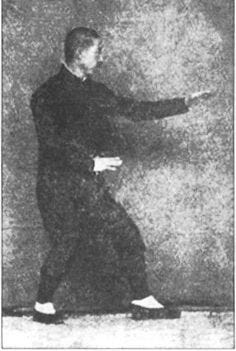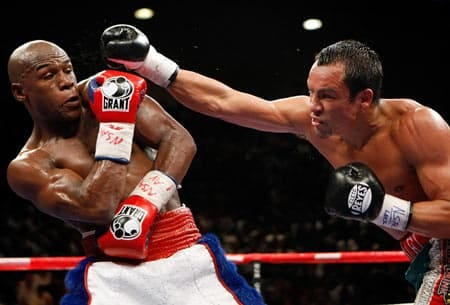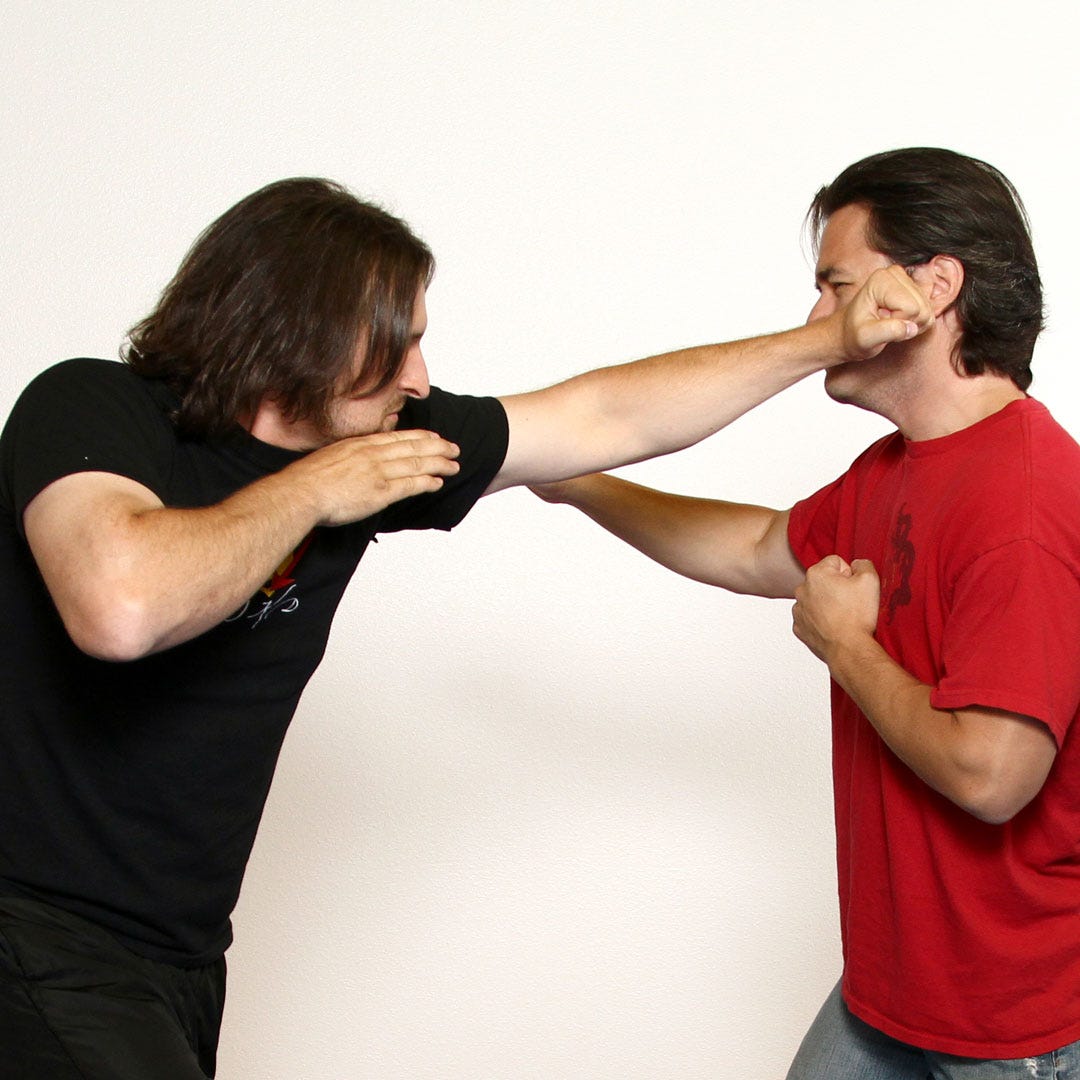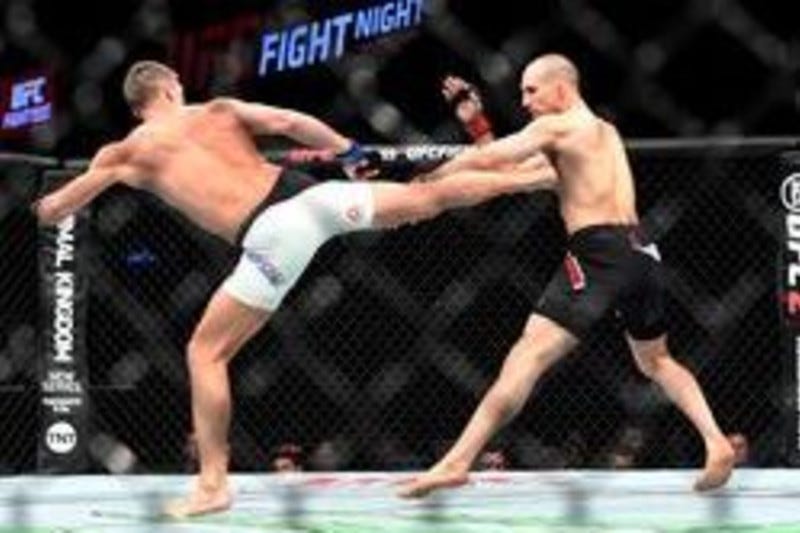If I had a penny for every time I have heard this debate within a martial arts gym, I would be quite rich. In most instances that I have witnessed, an individual was taught to fight in one of these stances and then comes to believe that it is the only proper way to fight. As I hope to demonstrate, both stances are effective, but it is entirely dependent on how one wishes to fight.
Overview of Key Characteristics
A bladed stance places the feet roughly parallel and the body is turned away from the opponent (to varying degrees), such that a roundhouse kick to the body would connect with the front of the opponent (chest and stomach) or back of the opponent. Generally, this stance is done with a wide base, such that the feet are further than shoulder-width apart. This stance is associated with Taekwondo, Karate, Kung Fu, and Bruce Lee.
In contrast, a squared stance places the feet diagonal from each other with at least one foot pointing forward. In this stance, the feet are at least shoulder-width apart. Generally, striking arts tend to have a smaller base (feet are closer together) than grappling arts, while utilizing this stance. This stance is associated with a wider variety of styles, such as Muay Thai, Krav Maga, and Wrestling.
Each of these stances has advantages and disadvantages. This in-depth analysis intends to dissect these. The characteristics of the bladed stance are as follows:
Stronger linear movement, weaker circular movement
Strengthen the lead, weaken the rear
Stronger linear attacks, weaker circular attack
Stronger defense against striking, weaker defense against grappling
Backfists, hammerfists, side kicks, and heel kicks become viable leading tools
Stronger in long-range, weaker in short-range
The characteristics of a squared stance are as follows:
Stronger circular movement, weaker linear movement
Less difference between the lead and rear hand
Stronger circular attacks, weaker linear attacks
Stronger defense against grappling, weaker defense against striking
Stronger grappling capabilities
Stronger in close-range, weaker in long-range
The Bladed Stance
The bladed stance is a potent tool. It allows for powerful, aggressive linear movement. Usually, this is done by exploding off the front or back leg, but it can also be done through switching stances. The explosive movement of the bladed stance usually derives from loading the weight onto the leg opposite of the direction one wants to move in and pushing off it. For example, if one wants to move forward, they will shift their weight onto their back leg and push off it. Similarly, if one wants to move backward, they will shift their weight onto their front leg and push off it. This allows for explosive movement that covers far more distance than traditional stepping.
Another way to generate explosive linear movement from the bladed stance is shifting stances by crossing the legs. One steps forward with their back leg, brings it past their front leg, and then shifts into the opposite stance. A general term for this sort of move is a charging step as it allows one to cover a large distance in a relatively short amount of time. Bajiquan and Xingyiquan are both known for utilizing a charging step.
Both forms of explosive movement contribute to striking power. In the case of the further, exploding off the back leg can add a ton of power to one’s strikes. As such, it is taught in martial arts as diverse as Boxing, Kung Fu, and Taekwondo. In the case of the latter, stepping through allows one to throw the whole weight of one’s body into the strike, generating a power more analogous to a sledgehammer than a whip.
However, this aggressive linear movement comes at the cost of substantially impaired circular movement. Unlike the squared stance, the bladed stance puts the fighter in an awkward position when moving circularly. As the feet are parallel with one’s side facing the opponent, one must either abandon their stance or run in their stance to move circularly. Both options are suboptimal as one must choose between changing stances or exposing themselves to easy attack. Given that bladed stances tend to be wider, this becomes harder as the wide stance hinders movement. As such, when it comes to circling off or creating angles of attack, the bladed stance is more limited.
Another key difference between the stances is that the bladed stance strengthens the lead at the cost of the rear. The bladed stance puts the lead hand significantly closer to the opponent, but in doing so pulls the rear hand further away. This is a double-edged blade. For those who enjoy fighting off the lead and being more aggressive, this can enable them to do so. However, it simultaneously weakens the power shots one can throw off the rear. Hence, in a bladed stance, I find myself utilizing flicking jabs and lead leg side kicks far more often. Yet, I also rarely throw kicks off my back leg. My cross (rear hand punch) and rear leg kicks tend to be saved for when I have made a mistake; usually, when my opponent has obtained a strong angle of attack, or they have gotten far closer than intended. For those who are more used to a square stance, fighting primarily off the lead can take time to become acquainted with. In my experience, it requires a higher level of speed, cunning, and aggression. If utilized successfully, it can be very overwhelming to be on the receiving end.
In the same vein as the prior two points, the bladed stance strengthens linear attacks at the cost of circular ones. Linear attacks that are difficult to throw from a squared stance become viable, such as side kicks, and many linear attacks that require greater balance become substantially easier to throw, such as linear head kicks. This comes at the cost of weaker circular attacks. As the legs are parallel, throwing roundhouse kicks and hooks becomes more difficult. The legs tend to be aligned with the center of the opponent, which makes roundhouse kicks harder to throw (except for the inside leg roundhouse kick). Also, the rear leg is so far back that rear leg roundhouse kicks tend to be quite telegraphed, making them easier to block or evade. The same issues arise for hook punches. As the hands tend to be aligned with the center of the opponent, throwing the hook becomes difficult as one must lean back, step out, or shrink the ark of the punch to make contact. Moreover, the rear hand is so far back that throwing a hook punch off it tends to be quite telegraphed, making it easier to block or evade. Given this, this stance tends to favor individuals who prefer linear strikes over circular ones.
Another distinct feature of this stance is its focus on striking over grappling. Bruce Lee, who favored a bladed stance, wrote, “The primary purpose of JKD [stance] is kicking, hitting, and applying bodily force. Therefore, the use of the on-guard position is to obtain the most favorable position for the above-mentioned.” The bladed stance provides for exceptional striking ability. It is not only used in hand-to-hand combat but it is also used in fencing and other weapons-based styles. This is due to several beneficial features, some of which have been mentioned previously. One feature yet to be discussed is the limiting of vital targets. Given the body is turned away from the opponent, the number of vital areas exposed becomes significantly reduced. The front (chest and stomach) is protected by the lead and rear hands. The side facing the opponent is protected by the lead hand. The head is protected by the lead hand and shoulder, allowing for easy pull counters. As the distance between the head and shoulder is punctuated by the trapezius muscle, strikes to the head, throat, and eyes become significantly more difficult. The back is exposed, but strikes to the back tend to be far less damaging than strikes to the head or solar plexus. The wider stance leaves the leg out as a tangible threat for any who get too close. In short, the stance leaves the opponent few available vital targets.
While this stance provides great protection from striking, it is much weaker in the area of grappling. The parallel legs and wider stance make it easier to get control of the lead leg for takedowns. In the same vein, parallel legs make it easy to knock over an opponent with a sweep or well-placed shove from the opponent’s front (chest and stomach) or back. Moreover, the bladed stance makes taking the back much easier as the individual is turned away from their opponent. The bladed stance deprives one of the horizontally wider base that is considered desirable for grappling.
The stance’s weak grappling capabilities are partially offset by the striking tools it makes available. Leading with backfists, hammerfists, side kicks, and heel kicks becomes viable with this stance. The lead hand in a bladed stance tends to vary from low to high. In this position, as the lead hand goes low, it is brought out to the side, enabling one to throw backfists and hammerfists. Similarly, this can be done by keeping the lead hand low. These tools are not usually available as leading with these techniques in a squared stance tends to leave one’s head too open. However, given the greater defensive capabilities of the bladed stance, one can throw these techniques with greater ease. Backfists can be especially effective if used as a variant of a jab as it allows for a quick flicking motion that can be both powerful and leave few opportunities for a counterattack. The bladed stance also enables lead side kicks and heel kicks. As side kicks have been mentioned already, it is worth focusing on heel kicks. Heel kicks are functionally reverse roundhouse kicks. Given this, they are often difficult to throw off the lead leg as they require the leg to be brought across the body to be effective. In a bladed stance, the leg is already aligned with the opponent’s center, such that angling off and bringing the leg across the body is significantly easier. This can be quite surprising to opponents who are not used to dealing with any heel kick that is not spinning. The greater availability of these tools enhances the striking focus of the bladed stance.
The last characteristic that is worth discussing here is the long-range nature of this stance. The bladed stance is not meant for close-range combat. The bladed stance’s weakness with grappling, linear movement, and focus on the lead, amongst numerous other characteristics, make this stance particularly unsuited for close-range combat. This can be seen in those who use this stance at a high level. Each one of them utilizes a hit-and-run style in which they focus on distance management and choosing engagements. The strategy is to keep one’s distance until they would like to engage at which point they explode in and then move back out. This hit-and-run style works very well with the explosive nature of the stance, and it weakens the opponent’s capacity to exploit the weaknesses of the stance. At a closer range, grappling becomes easier, circular movement becomes more important, and being able to use both hands to engage is key for dealing with the opponent.
Given the previous discussion, the bladed stance can be summed up as follows: it is an aggressive long-range stance focused on striking, linear movement, and linear attacks.1
Next Time
This is part one of a two-part series exploring both stances. The next article will be dedicated to discussing the squared stance in-depth. Please subscribe to stay up-to-date for when the next article drops. If you have a friend, family member, or acquaintance who would enjoy this content, please share.
Editor: Griffin Cadigan











